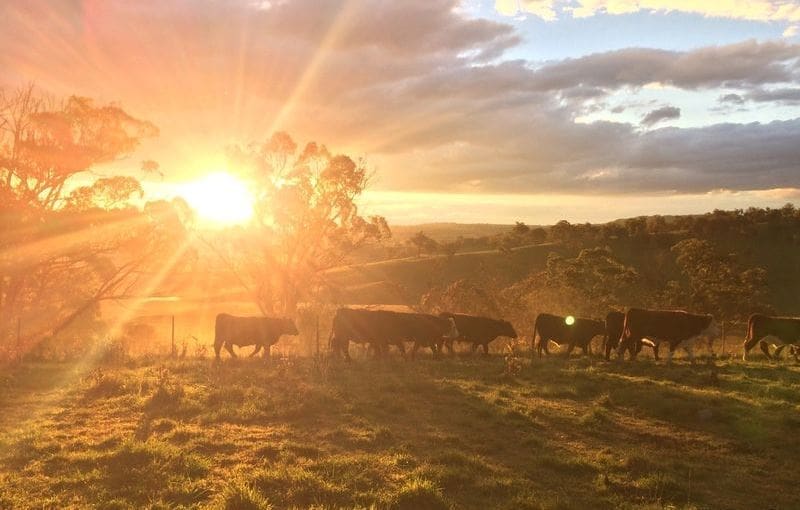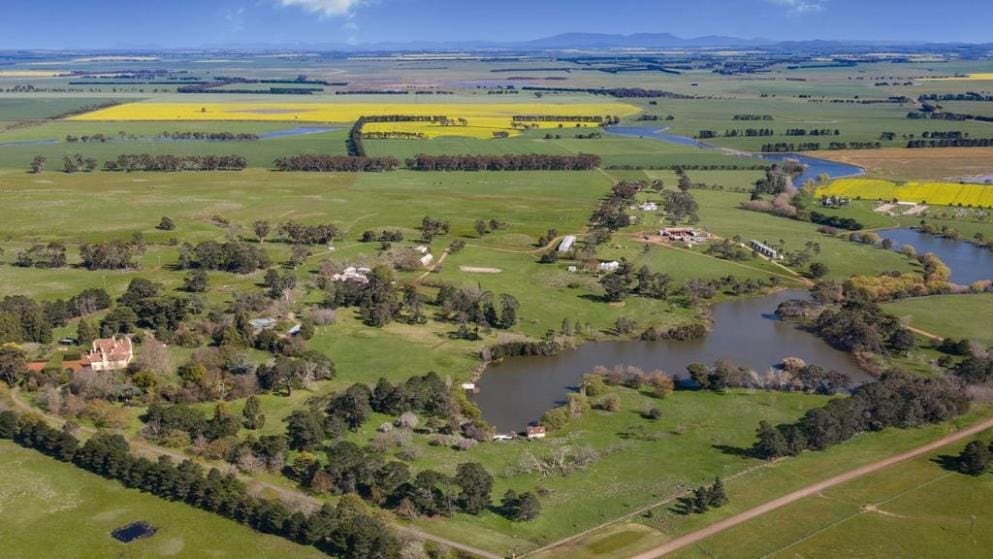
Last month, a couple from southern New South Wales paid $10.8 million ($9721/ha) for Boree at Walcha, an area regarded as some of the finest tablelands grazing land in New South Wales.
WITH Queensland land prices exceeding the previous peak of 2008, as reported in last week’s property review (click here to view) are other states following suit?
Feedback from property marketing experts in southern states suggests the robust appreciation in rural property values is being felt right across the continent.
With the Eastern Young Cattle Indicator hitting record highs in the past three weeks, livestock market sentiment is clearly one driver behind recent property values.
Mark Brooke, Nutrien Harcourts

Mark Brooke Landmark Harcourts
Melbourne-based Mark Brooke, Nutrien Harcourts general manager, said in certain sectors and certain locations in his region, property values were reaching new ceilings with demand continuing to exceed supply in a clear seller’s market.
“While it is fair to say that Northern Australian values previously peaked in 08/09, Southern Australian grazing values have continued an upward trend that commenced some time before that,” he said.
Mr Brooke said looking at property values from a national average, they were higher today than they had ever been, and were continuing to rise.
“After a long period in which the ag sector was generally overlooked by investors, it is now being seen as an attractive target. This is in large part due to improved annualised returns and capital growth providing diversity and performance advantage.”
“The industrialisation of the ag sector in general sees high demand for scaled operations from both the corporate/fund sector, as well as large-scale family or partnership enterprises which still represents a significant portion of Australian ag,” Mr Brooke said.
Tom Russo, Elders

Tom Russo, Elders
Adelaide-based Tom Russo, the general manager for Elders Real Estate, said market sentiment was undeniably buoyant.
“It is being largely driven by strong long-term fundamentals in demand for agricultural products and the resulting outlook for commodity prices. While GDP may take a hit in the short to medium term, populations continue to grow and there are more and more mouths to feed,” Mr Russo said.
He said existing owners retaining their assets and looking to expand explained the constrained supply of farmland offerings and the historically low transaction volumes over the past 18 months.
This has occurred at a time where there has been high demand on the buy side, driven primarily by a near perfect storm of variables, such as:
- Healthy commodity prices driven by strong long-term fundamentals in demand for Australian agricultural products globally
- Low cost of capital with record low interest rates
- A favourable Aussie dollar (notwithstanding recent appreciation)
- Access to capital with healthy farm balance sheets driven by strong operational performance and land appreciation, and
- Favourable seasonal conditions.
Mr Russo said these factors were driving market confidence.
“Many producers are seeking to acquire more land to expand their flocks and herds due to strong re-stocker prices. We are seeing DSE rates as high as $1000 in high rainfall areas (ie Western Victoria and New South Wales’ Eastern Riverina).”
He said farmers and neighbours seeking to realise economies of scale had been very active.
“Landowners who are able to leverage their existing cost-base are in a strong strategic position to outbid other interested parties, including corporates.”
“While some owners will be prepared to offer their properties to market given their improved presentation following favourable seasons, others will take advantage of the seasons to produce operational profits, and are therefore going nowhere,” Mr Russo said.
Even though recent sales and marketing activity suggested there will be a strong increase in listings this spring, particularly in areas coming out of drought, Mr Russo does not believe it will re-balance supply and demand and that it will remain a seller’s market for quite some time.
He played down any suggestion of a withdrawal of interest from corporate or institutional investors, saying a strong weight of capital was looking for a home in the Australian farmland market.
“There are more pools of capital than we’ve ever seen, ranging from local farmers through to Australian and offshore corporate farms and institutional investors accessing the market, through well establish intermediaries who now have solid track records justifying further investment,” he said.
Nick Myer, Elders VIC

Nick Myer
Nick Myer, Elders Victorian and Riverina region manager, agrees that prices in the southern states have easily succeeded the previous peak.
Despite the global pandemic, he said record pricing was being set in certain areas – particularly central and north eastern Victoria, New South Wales’ Riverina and Victoria’s western districts.
“There is a strong and renewed interest in agriculture because it is viewed as a sound asset class. Supply is tight, so any properties that are presenting themselves to market are being seized by people ready to capitalise on the opportunities,” Mr Myer said.
Standout sales
- March – the historic Western Victorian grazing property Mawallok sold to the Chinese-owned Tianyu Wool (one of the biggest buyers of Australian wool) for around $25 million. The 2349ha holding, 45 minutes west of Ballarat, boasts highly productive red volcanic and grey loam soils, outstanding water and can run 30,000 DSE.
- June – prominent Melbourne barrister Allan Myers paid more than $14 million for a portion of the iconic Western District grazing property Devon Park at Dunkeld. Featuring sweeping aspects over the Grampians National Park, the 1273ha of highly productive country is suitable for grazing 17,750 dry sheep equivalents, with portions suitable for cropping.

One of the largest wool top makers in the world, based in China, is believed to have paid around $25 million for the large Western Victorian grazing property Mawallok.
Col Medway, LAWD
Col Medway from LAWD (Land Agribusiness Water Development) believes land prices in New South Wales have blown away the peak of 2008.

Col Medway
“Values have risen consistently over the past five years. Back then, high rainfall country was selling for around $350/DSE bare. Today, there are plenty of sales in this region over $800/DSE.”
Mr Medway credits the rise to the ‘perfect storm.’
“Livestock is trading at a different band-level, low interest rates, the next generation (there are many ‘20 somethings’ coming home to the family businesses) and those seeking expansion, are just some of the influences.”
He said on top of that there had been a lot of ‘inbound’ capital into agriculture.
“Not just international or institutional capital – domestic capital from high-net worth individuals who are now viewing Australian agriculture as a favourable asset.”
Standout sales
- Last month, a couple from southern New South Wales paid $10.8 million ($9721/ha) for Boree at Walcha, an area regarded as some of the finest tablelands grazing land in New South Wales. The blue ribbon, high rainfall grazing property spanning 1111ha features fertile soils, quality improvements, secure water and can run 15,000 to 20,000 DSE.
- Another Walcha property, the 495ha Calala is currently under offer for around the $4.65 million ($9394/ha) asking price. Located in a high rainfall grazing region, it also features fertile soils, quality improvements, secure water and can carry 4950 DSE.
Western Australia
In Western Australia, most pastoral properties are sold on a walk-in walk-out basis, which means a portion of the price rise is attributed to the value of the cattle.

Elders Greg Smith
For example, in 2008/09, properties in more extensive grazing regions were typically achieving $600 per head for the cattle. Today that figure has risen to $1000.
Greg Smith, Elders pastoral sales specialist in WA, said in terms of bare land values, the best properties available on the market were achieving new high price levels.
“The overall market hasn’t pushed through to new levels. They are on par with the peak of 2008/09. However, quality properties are achieving premiums, and sometimes the price reflects the quality of the cattle,” he said.
Standout property
In July, Andrew “Twiggy” Forrest paid more than $30 million for his first Kimberley acquisition – the 221,408ha Jubilee Downs and Quanbun Downs.
Mr Smith said the price set a new benchmark on a per cattle unit basis for the region.
“Some of the extra value of the Fitzroy Crossing holding was reflected in the value of the 11,500 outstanding Droughtmaster cattle (mostly cows and calves) that were included in the sale. It was a ‘once in a lifetime’ opportunity and the cattle were exceptionally well bred.”
In Western Australia, Mr Smith said current buyers were predominately Australian.
“They are farming families and corporates. While some established players in Australia are participating, the notable but temporary absence is internationals buyers.”
He said reliable and premium production areas were highly sought after.
“Strong demand for quality properties means those holdings are lingering in the marketplace for an extensive period of time. Listings and buying activity should pick up after harvest.”
Mr Smith said the exception was southern areas which are in a hiatus over carbon credits, which has resulted in limited transactions.
“Producers in the Murchison and Goldfields areas are holding on because there could be a significant increase in property values once carbon farming on pastoral lands can be demonstrated as bankable income.”
